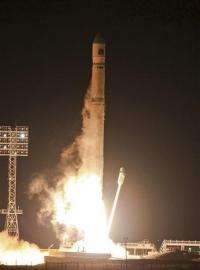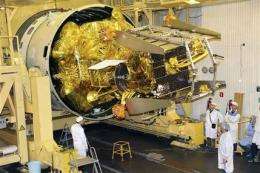The Zenit-2SB rocket with Phobos-Grunt (Phobos-Soil) craft blasts off from its launch pad at the Cosmodrome in Baikonur, Kazakhstan, early Wednesday, Nov. 9, 2011. The daring Russian mission to fly an unmanned probe to Phobos, a moon of Mars, and fly samples of its soil back to Earth was derailed right after its launch by equipment failure.(AP Photo/Oleg Urusov, Pool)
A Russian space probe aiming to land on a Mars moon was stuck circling the Earth after equipment failure Wednesday, and scientists raced to fire up its engines before the whole thing came crashing down.
One U.S. space expert said the craft could become the most dangerous manmade object ever to hit the planet.
The unmanned Phobos-Ground craft was successfully launched by a Zenit-2 booster rocket just after midnight Moscow time Wednesday (2016 GMT Tuesday) from the Russian-leased Baikonur cosmodrome in Kazakhstan. It separated from the booster about 11 minutes later and was to fire its engines twice to set out on its path to the Red Planet, but never did.
Russia's Federal Space Agency chief Vladimir Popovkin said neither of the two engine burns worked, probably due to the failure of the craft's orientation system. He said space engineers have three days to reset the spacecraft's computer program to make it work before its batteries die.
The mishap is the latest in a series of recent launch failures that have raised concerns about the condition of Russia's space industries. The Russian space agency said it will establish its own quality inspection teams at rocket factories to tighten oversight over production quality.
The $170 million Phobos-Ground was Russia's first interplanetary mission since a botched 1996 robotic mission to Mars, which failed when the probe crashed shortly after the launch due to an engine failure. Mars has two moons, Phobos and Deimos, and the latest spacecraft aimed to take ground samples on Phobos.
James Oberg, a NASA veteran who now works as a space consultant, said it's still possible to regain control over the Russia space probe.
"With several days of battery power, and with the probe's orbit slowly twisting out of the optimal alignment with the desired path towards Mars, the race is on to regain control, diagnose the potential computer code flaws, and send up emergency rocket engine control commands," Oberg said in an email to The Associated Press. "Depending on the actual root of the failure, this is not an impossible challenge."
In this Nov.2, 2011 photo distributed by Russian Roscosmos space agency on Wednesday, Nov. 9, 2011, Russian space engineers work to prapare the unmanned Phobos-Grunt probe on the Baikonur Cosmodrome, Kazakhstan. The daring Russian mission to fly an unmanned probe to Phobos, a moon of Mars, and fly samples of its soil back to Earth was derailed on Wednesday, Nov. 9, 2011, right after its launch by equipment failure.(AP photo/ Russian Roscosmoc space agency, HO) EDITORIAL USE ONLY
He warned, however, that the effort to restore control over the probe is hampered by a limited earth-to-space communications network that already forced Russian flight controllers to ask the general public in South America to help find the craft. Amateur astronomers were the first to spot the trouble when they detected that the spacecraft was stuck in an Earth orbit.
If the controllers fail to bring the Phobos-Ground back to life, the tons of highly toxic fuel it carries would turn it into the most dangerous manmade object ever to fall from orbit, Oberg warned.
"About seven tons of nitrogen teroxide and hydrazine, which could freeze before ultimately entering, will make it the most toxic falling satellite ever," he said. "What was billed as the heaviest interplanetary probe ever may become one of the heaviest space derelicts to ever fall back to Earth out of control, an unenviable record."
The spacecraft is 13.2 metric tons (14.6 tons), with fuel accounting for a large share of its weight. It was manufactured by the Moscow-based NPO Lavochkin, which has specialized in interplanetary vehicles since the dawn of the space era.
The company also designed the craft for Russia's botched 1996 launch and the two probes sent to Phobos in 1988 also failed. One was lost a few months after the launch due to an operator's mistake, and contact was lost with its twin when it was orbiting Mars.
In contrast with the failures that dogged Soviet and Russian efforts to explore Mars, a succession of NASA's landers and rovers, including Spirit and Opportunity, have successfully studied the Red Planet.
If Russian space experts manage to fix the Phobos-Ground, it will reach Mars orbit in September 2012 and land on Phobos in February 2013. The return vehicle is expected to carry up to 200 grams (7 ounces) of ground samples from Phobos back to Earth in August 2014.
It is arguably the most challenging unmanned interplanetary mission ever. It would require a long series of precision maneuvering for the probe to reach the potato-shaped moon measuring just about 20 kilometers (just over 12 miles) in diameter, land on its cratered surface, scrape it for samples and fly back.
Scientists had hoped that studies of Phobos' surface could help solve the mystery of its origin and shed more light on the genesis of the solar system. Some believe the crater-dented moon is an asteroid captured by Mars' gravity, while others think it's a piece of debris from when Mars collided with another celestial object.
Popovkin admitted the mission was risky and its failure would badly dent Russia's space prestige, but added it was essential to preserve the nation's technological expertise in robotic missions.
China has contributed to the mission by adding a mini-satellite that is to be released when the craft enters an orbit around Mars on its way to Phobos. The 115-kilogram (250-pound) satellite, Yinghuo-1, will become the first Chinese spacecraft to explore Mars, studying the planet during two years in orbit.
From now on, you can follow Physorg on Google+ too!
©2011 The Associated Press. All rights reserved. This material may not be published, broadcast, rewritten or redistributed.
























